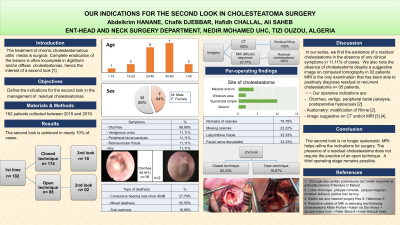Otology/Neurotology
(357) Our Indications for the Second Look in Cholesteatoma Surgery
Monday, October 2, 2023
2:45 PM - 3:45 PM East Coast USA Time

Has Audio

ABDELKRIM HANANE, MD
General ENT-HNS physician
Nedir Mohamed UHC, Tizi Ouzou, Algeria
Beni Douala, Tizi Ouzou, Algeria- CD
- HC
- AS
ALI SAHEB, MD
Nedir Mohamed UHC, Tizi Ouzou, Algeria, USA
Presenting Author(s)
Co-Author(s)
Disclosure(s):
ABDELKRIM HANANE, MD: No relevant relationships to disclose.
Introduction: The treatment of cholesteatomatous chronic otitis media is surgical, in which a complete eradication of the lesions is often incomplete in digitiform and/or diffuse cholesteatomas, hence the interest of a second-stage look.
Methods: It is a retrospective study including 182 patients operated on for chronic cholesteatomatous otitis media in our department, over a 5-year period from 2015 to 2019. The first operative stage consisted of a retroauricular incision with antro-attico-mastoidectomy and attic reconstitution with a functional procedure which was systematically performed. Post-operative monitoring was done at regular intervals of 03 months. 18 patients (10%) received a second look. The treatment indication was based on the following criteria: reappearance of otorrhea, vertiginous crisis, facial paralysis, retroauricular fistula, any, worsening of the hypocacusis and image suggestive to magnetic resonance.
Results: The second operative stage consisted of a closed technique n= 16 patients and an open technique n= 02 patients. We find the existence of a residual cholesteatoma in the absence of any clinical symptoms in 11.11% of cases. MRI is the only examination that has been able to positively diagnose residual or recurrent cholesteatoma n= 05 patients. We note the absence of cholesteatoma despite a suggestive image on computed tomography in 02 patients. The postoperative results are good with an average follow-up of 2 years. Our operative indications are: - Otorrhea, vertigo, peripheral facial paralysis, postoperative hypoacusis.
- Audiometry: modification of Rinne.
- Image suggestive on CT and/or MRI.
Conclusions: The second look is no longer systematic. MRI helps refine the indications for surgery. The presence of a residual cholesteatoma does not require the practice of an open technique. Second-stage look was recommended for selected patients.
